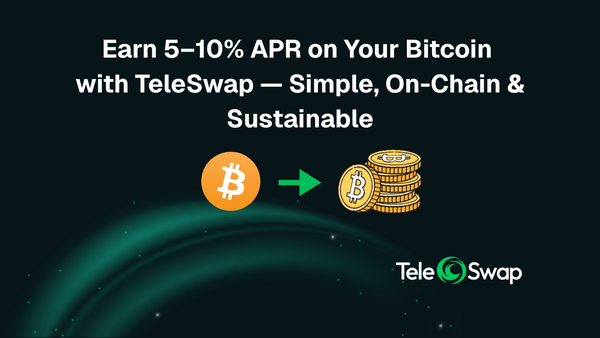How to Bridge Small Amounts of BTC to ETH (Low-Fee Strategies) [2025 Guide]
![How to Bridge Small Amounts of BTC to ETH (Low-Fee Strategies) [2025 Guide]](/content/images/size/w1200/2025/06/TeleSwap-87--2-.jpg)
Introduction
Transferring small amounts of Bitcoin (BTC) to the Ethereum (ETH) network can be challenging and costly. High network fees and bridge charges often eat up a large percentage of a small transfer. In 2025, more crypto users are making micro-transactions – whether funding a DeFi experiment, buying an NFT, or participating in Web3 with limited capital. However, bridging even $50–$200 worth of BTC to Ethereum can feel prohibitively expensive if you use the wrong method. This guide will outline the best low-fee strategies to bridge small BTC amounts to ETH. We’ll explore why fees are high, how to minimize them, and highlight cost-efficient platforms (like TeleSwap) and aggregators that make small Bitcoin to Ethereum transfers economical. By the end, you’ll know how to avoid high fees and choose the best BTC to ETH bridge for small amounts.
Challenges of Bridging Small BTC Amounts
Bridging BTC to Ethereum typically means converting BTC into an Ethereum-based equivalent (like WBTC or directly into ETH). When dealing with small amounts, a few key challenges arise:
- High Network Fees (Proportionally): Both Bitcoin and Ethereum have base transaction fees that don’t scale down for tiny amounts. Paying a $2–$5 Bitcoin miner fee to move $50 of BTC is a huge 4–10% cost. Ethereum gas fees can similarly be a few dollars or more per transaction. The fee overhead is high relative to the transfer amount.
- Fixed Withdrawal or Bridge Fees: Many services charge a flat fee regardless of the amount. For example, centralized exchanges often charge around 0.0005 BTC to withdraw BTC. Some bridges enforce minimum fees (e.g., a ~$5–$10 base fee, or ~$40 when using Ethereum mainnet bridges). If you’re only moving $100 of BTC, a $15–$40 fee is too expensive, sometimes exceeding the amount itself.
- Hidden Costs: Small transfers can be eroded by slippage and spreads. If a bridge or exchange uses an automated market maker or offers a poor exchange rate, you might lose an extra 0.5% or more without realizing it. Price volatility during slow bridging methods can also hit small amounts harder – if your transfer takes hours and BTC/ETH price moves, you could lose value by the time it arrives.
- Minimum Limits: Some platforms set minimum BTC amounts to bridge or swap. If the minimum is 0.01 BTC (~hundreds of dollars), then smaller holders are effectively shut out or forced to use less efficient workarounds.
Bottom line: With small BTC transfers, every dollar of fees matters. High fees and hidden costs can turn a small cross-chain swap into a losing proposition. Next, we’ll break down where these fees come from so you can make informed choices.
Understanding Bridge Fees and Costs
When bridging BTC to ETH, multiple fees come into play. Understanding them helps you find a low-cost BTC to ETH strategythe :
- Bitcoin Network Fee: This is the BTC miner fee to send a transaction on Bitcoin’s blockchain. It’s essentially a flat cost (varies with congestion), whether you send 0.001 BTC or 1 BTC. For small transfers, this base fee (often around $1–$5 in 2025 during normal periods) can be a large percentage. During peak network usage, BTC fees can spike higher, so timing matters.
- Ethereum Gas Fee: To receive assets on Ethereum (or to mint WBTC, or swap into ETH), you’ll pay gas. On the Ethereum mainnet, gas fees in 2025 might range from a couple of dollars to over $10, depending on activity. If you use a layer-2 (like Arbitrum or Polygon) for the bridging step, this cost can be pennies – something we’ll discuss in strategies. Either way, Ethereum fees will cut into your final amount of ETH.
- Bridge Service Fee: Most bridges or swap services charge their own fee. This could be a percentage fee or a flat fee. For example, TeleSwap charges a flat 0.1% fee on the amount bridged (just $0.10 on a $100 transfer). In contrast, some multi-chain bridges or exchanges might charge a flat amount (e.g. $5), which is steep for small sums. Percentage-based fees scale with your transfer, whereas flat fees hurt small users more.
- Slippage and Spread: If the bridging involves swapping BTC to WBTC or ETH via an automated market maker, you may lose a bit to price slippage. THORChain, for instance, has a minimum ~0.16% liquidity fee on swaps. Additionally, services might bake in a spread, giving you a slightly worse BTC/ETH rate than the market price (a hidden fee). Always compare the BTC-ETH conversion rate you’re offered to the market rate. Transparent bridges will show you the rate; custodial services might not.
- Miscellaneous & Opportunity Cost: Centralized routes require deposit and withdrawal steps, which not only incur fees but also time delays. Waiting for confirmations and processing can take 30 minutes or more, during which crypto prices might move against you. A fast bridge reduces this risk. Also, double-check if any wrap/unwrap fees or custodial fees apply for certain services.
Knowing these costs, it’s clear that small BTC-to-ETH transfers require picking the right time and tool to keep fees minimal. Next, let’s look at low-fee strategies to achieve this.
Top Low-Fee Strategies for Bridging Small BTC to ETH
To bridge small amounts of BTC to ETH with low fees off-hours, use a combination of smart timing and optimal platforms:
- Time Your Transaction: Both Bitcoin and Ethereum fees, fluctuate with network congestion. Plan your bridge during off-peak times. For Bitcoin, fees tend to be lower when the mempool isn’t crowded (for example, early mornings or weekends can sometimes see less activity). Similarly, Ethereum gas prices might dip during weekends or off-hours. By waiting for a low-traffic window, you can save significantly on network fees.
- Use Low-Cost Bridges Optimized for Small Amounts: Not all bridges are equal. Prefer decentralized bridges with transparent, low fees (especially percentage-based fees with no high minimum). A flat 0.1% fee (as TeleSwap has) is ideal for small transfers – it means you pay in proportion to your amount. Avoid services with high fixed fees or that require you to transfer a large minimum. In practice, low-cost decentralized bridges BTC to ETH (like TeleSwap) let even micro transfers go through with minimal overhead.
- Leverage Bridge Aggregators: If you’re not sure which route is cheapest, let an aggregator find it. Cross-chain aggregators (e.g., Rubic, Rango, DZap) automatically compare routes and fees across multiple bridges and DEXs. They will choose the path that yields the most ETH for your BTC after all fees. Aggregators are great for small amounts because they factor in every fee and even split routes if needed to optimize cost. Often, these aggregators will route through the lowest-fee BTC to ETH bridge, available. (In many cases, they pick TeleSwap for BTC↔ETH swaps due to its low fee, as it frequently offers the cheapest BTC to ETH swaps route.)
- Consider Layer-2 Solutions: If possible, perform parts of the transfer on layer-2 networks to save on gas. For example, TeleSwap can bridge BTC to WBTC on Polygon (a low-fee network), and then you can move that WBTC to Ethereum L1 or use it on Polygon’s DeFi. While this may add an extra step, it can drastically cut Ethereum gas costs for the bridging step. Some aggregators handle this automatically (e.,g. moving WBTC via Polygon or Arbitrum to save fees).
- Avoid Double Conversion & Middlemen: Each extra step (like converting to a stablecoin then to ETH, or using two different bridges) adds fees. The best BTC to ETH bridge for small amounts is one that does it in as few steps as possible. A direct BTC-to-ETH swap (or BTC-to-WBTC) will usually be cheaper than depositing to an exchange, trading, and withdrawing. Fewer hops mean fewer transaction fees and less slippage.
By applying these strategies – timing, the right bridge, aggregator help, and minimizing steps – you can bridge even micro BTC amounts without paying a fortune. Now, let’s compare specific bridge options and see how they stack up on fees.
Bridge Options for Small BTC Amounts (Fee Comparison)
When moving BTC to Ethereum, you have a few categories of options. Here’s a comparison of how they handle fees and small transfers:
- TeleSwap (Decentralized Bridge): TeleSwap is a purpose-built decentralized BTC↔ETH (via WBTC) bridge with a flat 0.1% fee. This is extremely low – on a small amount like 0.005 BTC, the TeleSwap protocol fee is almost negligible (only 0.000005 BTC). Network fees are also optimized: TeleSwap uses efficient routes (often involving Polygon) to keep gas costs down. There are no extra commissions or hidden spreads. For users, that means what you see is what you get – just pay Bitcoin’s network fee and 0.1%. TeleSwap’s decentralized design has no KYC, and it completes swaps in as little as 2–5 minutes (often ~3 minutes for an average trade. This speed and low cost make TeleSwap ideal for small transfers. You won’t lose a big chunk of your 0.002 or 0.01 BTC to fees, and you remain in control of your funds throughout. Bottom line: TeleSwap is a low-cost decentralized bridge BTC to ETH is and especially friendly to small transactions.
- THORChain (Decentralized Bridge): THORChain is another decentralized cross-chain swap protocol that supports BTC↔ETH (BTC to WBTC) swaps without custody. It doesn’t have a simple percentage fee like TeleSwap; instead, THORChain charges a liquidity fee (slippage-based) and a fixed outbound fee for BTC. For small amounts, that fixed portion can be significant. (THORChain’s outbound fee roughly equals the on-chain Bitcoin fee, sometimes multiplied for faster confirmation, often ending up around a few dollars minimum.) Additionally, THORChain’s percentage-based liquidity fee might be around 0.2–0.3% or more, depending on pool conditions. In practice, a tiny BTC swap might face a total fee of a few dollars on THORChain – not terrible, but usually higher than TeleSwap’s 0.1%. THORChain has no KYC and is trust-minimized, which is good, but for very small BTC amounts the fee structure isn’t as favorable. It shines more for medium to large swaps. Use it if you need its other features, but be mindful that minimum BTC transfer fees to ETH on THORChain can be a bit heavy for micro-transfers.
- Binance/Coinbase (Centralized Exchanges): Many users instinctively consider a major exchange as a bridge – deposit BTC, trade it for ETH, withdraw ETH. This works, but fees stack up in multiple steps. Exchanges often don’t charge for crypto deposits, but you’ll still pay the Bitcoin network fee to send your BTC in. Then the exchange trade fee (typically ~0.1% of the trade value) is minor, but the withdrawal fee is the killer: to withdraw ETH from a CEX you usually pay a flat fee (e.g. 0.003 ETH on Coinbase or similar, which might be $5+). Some exchanges charge ~0.0004 BTC to withdraw BTC or a few dollars in ETH to withdraw Ethereum. For small transactions, these flat fees are disproportionately high – withdrawing $50 of ETH and paying $5 means 10% lost right there. Additionally, using a CEX means slower processing (you wait for deposit confirmation, the trade, then the withdrawal confirmation) which can easily be 30+ minutes total. There’s also the aspect of KYC and trust – your funds are custodial on the exchange during the process. In short, while Binance or Coinbase are reliable for large conversions, they are not low-cost for small BTC to ETH transfers due to their fee structure. You might consider a CEX if you already have funds on it and can batch the transfer with other needs, but otherwise, decentralized bridges or aggregators are usually cheaper and faster for micro amounts.
- Bridge Aggregators (Rubic, Rango, DZap, etc.): Bridge aggregators are like Kayak or Skyscanner for crypto transfers – they find you the cheapest and best route automatically. If you use an aggregator’s interface to bridge BTC to ETH, it might evaluate TeleSwap, THORChain, plus any other available paths (maybe even intermediate swaps through stablecoins or other chains) to maximize what you receive. For small transfers, aggregators are extremely useful because they’ll take into account all the fees and slippage and often choose the route optimized for low fees. For instance, Rubic’s “Best Route” finder has integrated TeleSwap and often ranks it #1 for BTC swaps (since TeleSwap’s low fee gives it an edge). Aggregators also sometimes waive their own service fee for small trades – e.g., Rubic has run promotions with no protocol fee on swaps under $100. The beauty is simplicity: you don’t have to manually compare TeleSwap vs. THORChain vs. others; the aggregator does it for you in real time. Just be aware that using an aggregator introduces an extra smart contract in the process (the aggregator’s contract), but reputable ones are audited. They may also show you multiple choices, like fastest vs. cheapest route. In general, the best aggregators for low BTC to ETH fees, will guide you to a solution that likely involves a low-cost bridge (often TeleSwap) behind the scenes. It’s a beginner-friendly way to ensure you’re not overpaying.
Fee comparison summary: For small BTC amounts, decentralized bridges with low percentage fees come out on top – TeleSwap, in particular, offers the best combination of low fees, speed, and no minimums. THORChain is decentralized and secure but can be pricier for small sizes. Centralized exchanges work but tend to have the highest hidden costs for small transfers (due to fixed fees). Aggregators are highly recommended to automatically find the cheapest path – often directing users to solutions like TeleSwap for the actual swap.
Real-World Example: Bridging 0.005 BTC to ETH
Let’s put numbers to it. Suppose you want to bridge 0.005 BTC (about a few hundred dollars, depending on BTC’s price) to Ethereum. How much ETH will you end up with using different methods?
- Using TeleSwap: 0.005 BTC minus the 0.1% fee leaves 0.004995 BTC. TeleSwap will deduct a Bitcoin network fee from that (or require you to pay it in the process). Say the BTC network fee is ~0.0001 BTC (just an example $3 fee). That leaves ~0.004895 BTC worth delivered as WBTC/ETH (TeleSwap can directly convert to WBTC on Ethereum). On the Ethereum side, you’d pay a small gas fee to receive the WBTC or swap to ETH. If TeleSwap is using Polygon or an efficient route, that might only be, say, $1 worth. In total, you might spend around ~$4 in fees. You’d receive roughly 0.004895 BTC worth of ETH. In ETH terms (if 1 ETH = 0.0666 BTC for easy math, i.e., ETH ~$1500), that would be about 0.0735 ETH. The fee overhead is only ~2-3% in this scenario, quite good for a cross-chain micro swap.
- Using THORChain: 0.005 BTC goes into THORChain’s BTC pool. You’ll pay a slip-based fee; with THORChain’s minimum slip of ~0.16%, that’s ~0.000008 BTC. There’s also an outbound Bitcoin fee (perhaps ~0.0001 BTC or slightly more to ensure fast confirmation). So you might end up with around 0.00489 BTC worth of ETH after fees. Additionally, THORChain transactions involve an extra on-chain step (to its vaults), so you’ll also pay an ETH gas fee when receiving the output (if it delivers WBTC or swaps to ETH through a DEX like THORSwap). Let’s assume another $2 there. All in, you might effectively lose $5+ in value. You could end up with roughly 0.0048 BTC worth of ETH (~0.072 ETH). That’s a bit less than TeleSwap’s result – maybe 4-6% total cost. Still decent, but not the cheapest.
- Using Binance/Coinbase: You send 0.005 BTC to the exchange (pay ~0.0001 BTC miner fee yourself). Now you have 0.0049 BTC on the exchange. You trade it to ETH (0.1% trading fee, negligible ~0.0000049 BTC). You withdraw ETH to your wallet; assume the exchange charges a flat 0.001 ETH withdrawal fee (around $2–$3). Converting 0.0049 BTC to ETH at market rate (again ~0.0735 ETH before fees). After paying the withdrawal fee, you might receive 0.0725 ETH. But recall you also spent 0.0001 BTC ($3) initially to deposit. In total you lost around $5–$6 in various fees. The final ETH value might equate to ~0.0048 BTC worth. The percentage cost here could be 5–7% of the original amount, plus the process took longer and required trust in the exchange.
- Using an Aggregator: The aggregator will likely choose TeleSwap or a similar route for you. Let’s say it chose TeleSwap. In that case, the outcome should mirror the TeleSwap scenario (~0.073+ ETH received). The aggregator’s fee might be zero for this amount, or very small (some aggregators earn a tiny commission, but often it’s built into what you see). Thus, aggregator = best underlying route. If TeleSwap wasn’t available, the aggregator might have chosen THORChain or a combo route, but since TeleSwap is integrated and usually cheapest, that’s the most probable path. End result: maybe you get 0.073 ETH, nearly the same as using TeleSwap directly. The aggregator just saved you the trouble of figuring it out.
Result: Among these, TeleSwap delivered the most ETH for 0.005 BTC in our example, thanks to its minimal fees. THORChain and the CEX route both gave slightly less ETH, meaning higher effective fees. The aggregator performed as well as the best option it had (TeleSwap), confirming it’s a safe choice to get the optimal outcome. The difference in final amount may look small in ETH, but if you’re doing frequent small transfers or if your amounts are a bit larger, TeleSwap’s savings add up significantly. Using a low-fee bridge can mean keeping an extra 2-5% of your money in your pocket instead of paying it out in fees.
Why TeleSwap is Recommended for Small Transfers
Throughout this guide, we’ve highlighted TeleSwap as a top choice. Here’s a quick recap of why TeleSwap stands out for small BTC→ETH bridges:
- Lowest Fee Structure: TeleSwap’s protocol fee is only ~0.1%, with no fixed surcharges. There’s no “minimum fee” penalty – 0.1% of $50 is just 5 cents! This beats most competitors, where a small user might pay $5 or more in base fees. TeleSwap’s fees are transparent and flat, which gives small-budget users a fair shake
- Fast Swaps Reduce Risk: Speed matters when moving between volatile assets. TeleSwap completes BTC to WBTC/ETH swaps in a few minutes on average,. For small amounts, this means you’re less exposed to price swings during the transfer. Quick completion also means you can move on to using your ETH or DeFi funds right away, rather than waiting for lengthy confirmations or exchange processing.
- No Custody, No KYC: TeleSwap is non-custodial and decentralized. You don’t need to register an account or go through identity checks to use it. This is great for privacy and convenience,for especially if you’re just trying to move a small bit of BTC for some on-chain activity. Your BTC and ETH stay in your wallets except during the atomic swap process. There’s no risk of an exchange freezing your small account or a custodial bridge holding your funds. Security is high due to smart contracts and TeleportDAO tech verifying everything on-chain.
- Optimized for Small & Large Alike: TeleSwap’s model (using a single liquidity pool on Polygon for WBTC liquidity, etc.) yields low slippage even on larger trades. For small trades, slippage is zero – you get nearly a 1:1 rate BTC for WBTC/ETH. There are no minimum amount requirements; you can swap even 0.001 BTC if you want. The platform is built to be efficient for all sizes, which is reassuring for small users that they aren’t at a disadvantage.
- Aggregator-Approved: Top aggregators like Rubic and Rango have integrated TeleSwap and often route BTC swaps through it when it offers the best BTC to ETH bridge rate. This external validation means that even when you’re not using TeleSwap directly, it’s frequently working behind the scenes to provide you a better deal. TeleSwap being recommended by aggregators is a strong sign that its fees are consistently among the lowest.
In short, TeleSwap addresses all the pain points of bridging small amounts: it keeps fees ultra-low, avoids hidden costs, and maintains speed and security. For a beginner or any user who wants to avoid high fees when bridging BTC to ETH, TeleSwap is an excellent go-to solution.
Checklist: How to Save Fees Bridging Small BTC Amounts
Before you initiate your next BTC→ETH transfer, run through this quick checklist to ensure you’re minimizing fees:
Use decentralized bridges with transparent, low fees,. Platforms like TeleSwap (0.1% fee) are ideal. Avoid bridges or swaps that take a big cut or have high fixed charges.
Choose an aggregator service to find the best route. Aggregators will automatically pick the cheapest combination of swaps and bridges, saving you the manual comparison work.
Check current network fees on Bitcoin and Ethereum. If they’re unusually high, consider waiting if your transfer isn’t urgent. A lower congestion period can make a noticeable difference, especially for Bitcoin’s flat miner fees.
Avoid centralized exchanges for small transfers. The withdrawal fees on exchanges (and the hassle of deposit/trade/wait) make them suboptimal for little amounts. Decentralized routes are usually more cost-effective below a certain dollar threshold.
Double-check all addresses and transaction details. Mistakes can be very costly. If you send BTC to the wrong address or choose the wrong output network (e.g., accidentally send to a BTC deposit address that isn’t yours), you could lose the entire amount. Always verify you’ve entered your Ethereum wallet correctly for the bridge output, etc. It only takes a moment and prevents expensive errors.
By following this checklist, even newcomers can confidently bridge small Bitcoin amounts to Ethereum without falling into common traps. (For more tips, you might also read our guide on Common Mistakes When Bridging BTC to ETH (and How to Avoid Them) – it covers scenarios to beware of and how to swap smoothly.)
Conclusion & Recommendations
Moving small amounts of Bitcoin onto Ethereum no longer has to be prohibitively expensive. The key takeaways to remember:
- Timing matters: Whenever possible, execute your BTC→ETH bridge when network fees are low. This reduces the base cost on both chains.
- The fee structure is everything: Bridges that charge a low percentage (and no large flat fee) are your friend. In 2025, flat 0.1% style fees are the gold standard for cost-efficiency – much better than a $10 minimum fee some services impose. TeleSwap’s low flat fee model exemplifies this user-friendly approach, consistently beating others on cost for small swaps.
- Use smart tools: Don’t hesitate to use aggregator platforms or refer to fee comparison resources (like our bridging fees breakdown article) to see which option is best at the moment. Crypto markets evolve, and while we highlight TeleSwap as an excellent choice, an aggregator will ensure you’re informed of any route that might temporarily be cheaper. That said, TeleSwap’s combination of low fees and speed often makes it the best BTC to ETH bridge for small amounts under most conditions.
In summary, bridging small amounts can be done economically by choosing the right platform and strategy. We recommend trying TeleSwap for your next BTC→ETH transfer to experience how seamless and affordable it is for yourself. With minimal fees and quick swaps, even a tiny bit of Bitcoin can be converted to Ethereum without waste.
Ready to swap? Check your optimal BTC→ETH bridge route now on TeleSwap Academy (our platform regularly compares options for you), or head over to TeleSwap directly to make your transfer. Empower your Bitcoin – no matter how small – to join the Ethereum ecosystem with low-cost strategies that maximize your value.
FAQ
Q: What is the cheapest way to bridge small amounts of BTC to ETH?
A: Using a decentralized bridge with low fees (like TeleSwap) is typically the cheapest method. TeleSwap only charges ~0.1% plus network costs, making it one of the lowest-fee BTC to ETH bridges for small sums. In contrast, many alternatives have higher percentage fees or flat charges that end up costing more for small transactions. Additionally, using an aggregator can help find the absolute cheapest route automatically, which often ends up being TeleSwap or a similar low-cost bridge.
Q: How much does TeleSwap charge for small BTC to ETH swaps?
A: TeleSwap charges a flat 0.1% fee on the bridged amount, no matter how small or large. There are no extra service fees on top of that – just the unavoidable network transaction fees (BTC and ETH gas costs), which TeleSwap keeps as low as possible. For example, if you bridged $200 of BTC, TeleSwap’s protocol fee would be only about $0.20 worth of BTC. This ultra-low fee is why TeleSwap is recommended for small BTC swaps. You get a fair conversion with only a tiny fraction taken as a fee.
Q: Are there minimum amounts for bridging BTC to ETH?
A: It depends on the platform. Many decentralized bridges (TeleSwap, THORChain, etc.) do not impose a strict minimum – you could technically swap even $10 worth of BTC. However, very small amounts may not be practical because the network fees (Bitcoin miner fee, Ethereum gas) will consume a lot of it. Some custodial services or exchanges do set minimums (for instance, an exchange might not let you withdraw less than 0.001 BTC, or a bridge might require at least ~$50 equivalent). TeleSwap does not have a high minimum limit, making it suitable for small transactions. It’s always smart to check the service’s FAQ or do a test with a small amount if you’re unsure of minimums.
Q: How do I minimize Ethereum gas fees when bridging small amounts?
A: There are a few tactics:
- Use Layer-2 networks for the bridging step if possible. Some bridges will let you receive WBTC or ETH on Polygon, Arbitrum, or other L2s where gas fees are cents. You can later move it to mainnet or use it on those networks. TeleSwap, for example, can deliver WBTC on Polygon to save you money.
- Time your Ethereum transaction during lower activity periods (when Gwei is cheap). Avoid days of major NFT launches or memecoin crazes when gas prices spike.
- Optimize contract calls: If you’re going through an aggregator, it might bundle steps to save gas. Also ensure you’re not doing extra swaps – a direct bridge is one transaction on each chain, whereas a multi-step manual process could be multiple Ethereum transactions (costing more gas). By being mindful of when and how you’re transacting on Ethereum, you can keep gas fees from eating into your small transfer.
Q: Can aggregators reduce my BTC to ETH bridging fees?
A: Yes, aggregators can be very effective in reducing fees or at least finding you the best deal. An aggregator like Rubic or Rango will scan multiple bridges and DEX routes to see which yields the most ETH for your BTC after all fees. This means if one route has a lower bridge fee or better rate, you’ll automatically be pointed to it. Aggregators may also split your swap or use creative paths to shave off costs (for example, perhaps swapping to a stablecoin on one chain then bridging might be cheaper at a given moment – the aggregator will figure that out). They also often have partnerships; as noted earlier, some aggregators waive their own fee on small trades, so you’re essentially just paying the underlying protocol fees. The result is that without any extra effort, you often get a lower total fee than if you picked a single service at random. In summary, aggregators simplify the process and usually ensure you’re not overpaying. Just stick to trusted aggregator platforms that integrate reputable bridges.
Further Reading:
If you found this guide helpful, you may also enjoy our in-depth article on Bridging Fees Breakdown: What Does It Cost to Bridge BTC to ETH in 2025? which compares more scenarios and platforms. Also check out Common Mistakes When Bridging BTC to ETH (and How to Avoid Them) to steer clear of easy-to-prevent errors, especially if you’re new to cross-chain transfers. Once your BTC is on Ethereum, you might be interested in the Best Ways to Earn Passive Income with Bitcoin in 2025, where we discuss how to put that bridged BTC (as WBTC/ETH) to work in DeFi. Happy bridging, and welcome to low-fee cross-chain freedom!
,




